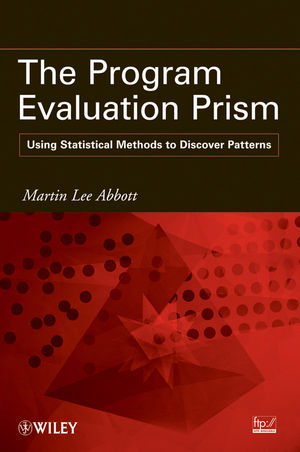The Program Evaluation Prism: Using Statistical Methods to Discover PatternsISBN: 978-0-470-57904-6
Paperback
324 pages
November 2010
 This is a Print-on-Demand title. It will be printed specifically to fill your order. Please allow an additional 10-15 days delivery time. The book is not returnable.
|
||||||
Initial Considerations.
Book Plan.
Real Examples.
Using Statistical Programs.
The Evaluator’s Journey.
CHAPTER TWO: THE ELEMENTS OF EVALUATION.
Nature of Evaluation.
Evaluation Concerns.
Evaluation Standards.
Methods used in Evaluation.
The Evaluator’s Tools.
Evaluation Hurdles.
Quantification.
Resistance to Quantification.
The Nature of Quantification.
Qualitative Methods.
Specialization.
Statistical Issues.
Certainty vs. Probability.
Statistical Significance.
Effect Sizes.
Can We Achieve Certainty?
Dispelling the Mystique of Statistics.
Research Literacy.
The Discovery Questions.
School Characteristics and Student Learning.
Worker Participation.
The Impact of Technology on the Classroom.
Classroom Observation Data.
Discovery Learning.
Terms and Concepts.
CHAPTER THREE: Using SPSS?
General Features.
Management Functions.
Reading and Importing Data.
Sort.
Split File.
Transform/compute (creating indices).
Merge.
Analysis Functions.
Graphing Functions.
CHAPTER FOUR: CORRELATION.
The Nature of Correlation.
Prediction.
Correlation is not Causation.
Pearson’s r.
Strength and Direction.
A Note on the Nature of the Data.
Interpreting Pearson’s r.
Testing the Statistical Significance of a Correlation.
The "Practical Significance" of r: Effect Sizes.
An Evaluation Example of Correlation: The Impact of Technology on Teaching and Learning.
Influences on Correlation.
Restricted Range.
Extreme (outlier) Scores.
Other Kinds of Correlation.
A Research Example of Spearman’s rho Correlation.
Non Linear Correlation.
"Extending" Correlation to Include Additional Variables.
Correlation - Detail for the Curious.
Computing Pearson’s r.
Assumptions of Correlation.
Non-Linear Correlation.
Discovery Learning.
Terms and Concepts.
Practical Application-Correlation.
Description of the Data.
Evaluation Questions.
CHAPTER FIVE: REGRESSION.
The Regression Line - Line of "Best Fit".
The Regression Formula.
Standard Error of Estimate.
Confidence Interval.
Residuals.
Regression Example with Achievement Data.
The Results of the Analysis.
The Graph of the Results.
Standard Error of Estimate.
The Confidence Interval.
Detail - for the curious.
Assumptions of Regression.
Fixed vs. Random Effects Modeling.
Non-Linear Correlation.
Calculating the Standard Error of the Estimate.
Discovery Note.
Terms and Concepts.
Practical Application - Bivariate Regression.
CHAPTER SIX: CLEANING THE DATA - DETECTING OUTLIERS.
Univariate Extreme Scores.
Multivariate Extreme Scores.
Distance Statistics.
Influence Statistics.
Discovery Note.
Terms and Concepts.
Practical Application - Extreme Scores.
CHAPTER SEVEN: MULTIPLE CORRELATION.
Introduction.
Control Variables.
Mediator Variables.
Using Multiple Correlation to Control Variables: Partial & Semi-partial correlation.
Partial Correlation.
Semi-partial (Part) Correlation.
Discovery Note.
Terms and Concepts.
Practical Application - Partial and Semi-Partial Correlation.
CHAPTER EIGHT: MULTIPLE REGRESSION.
Multiple Regression With Two Predictor Variables.
Uses of Multiple Regression.
Multiple Regression Outcomes.
Omnibus Findings for the Overall Model.
Individual Predictors.
Additional SPSS® Results.
Multiple Regression: How to Enter Predictors.
Stepwise Regression and Other Methods.
Assumptions of Multiple Regression.
Multicollinearity.
Cleaning the Database.
Multiple Regression with More Than Two Predictor Variables: Research Examples.
Predicting the Impact of School Variables on Teaching and Learning: the TAGLIT Data.
Omnibus Findings.
Results of Individual Predictors.
Discovery Notes.
Terms and Concepts.
Practical Application: Multiple Regression.
CHAPTER NINE: CODING - USING MLR WITH CATEGORICAL VARIABLES.
Nature of Dummy Variables.
One Categorical Variable with Two Groups.
Creating Dummy Variables.
Creating Subvariables in SPSS®.
One Categorical Variable with More Than Two Groups.
A Hypothetical Example.
An Example from the School Database.
Discovery Notes.
Detail for the Curious.
False Dichotomies.
Discovery Note.
Terms and Concepts.
Practical Application: Dummy Coding.
CHAPTER TEN: INTERACTION.
Interactions with Continuous Variables.
Interaction with Categorical Variables.
Discovery Notes.
Terms and Concepts.
Practical Application - Interaction.
CHAPTER ELEVEN: DISCOVERY LEARNING THROUGH CORRELATION AND REGRESSION.
Overall Discovery Notes.
Findings from the Data.
Student Academic Achievement.
Workplace Participation.
The Impact of Technology on Student Learning.
Advanced Statistical Techniques.
Hierarchical Linear Regression.
Structural Equation Modeling and Path Analysis.
Other Regression Procedures.
CHAPTER TWELVE: PRACTICAL APPLICATION ANALYSES.
Practical Application: Correlation.
Practical Application: Bivariate Regression.
Practical Application: Extreme Scores.
Practical Application: Partial and Semi-Partial Correlation.
Practical Application: Multiple Regression.
Practical Application: Dummy Coding.
Practical Application: Interaction.
REFERENCES.



